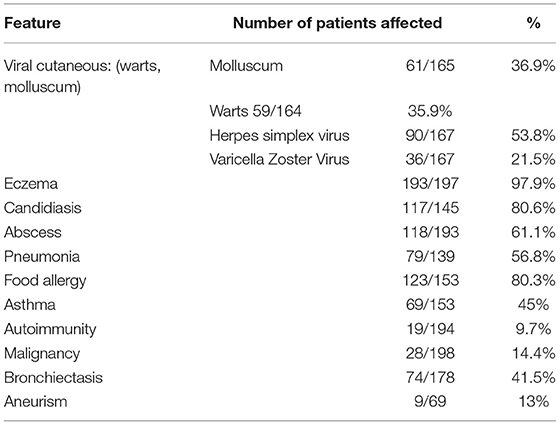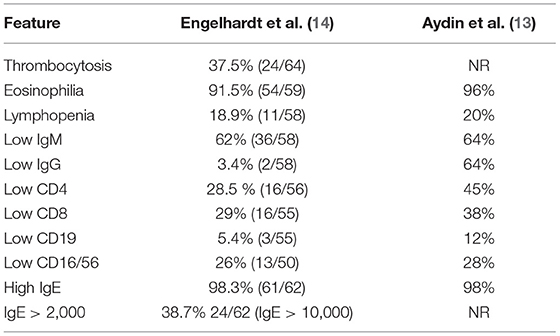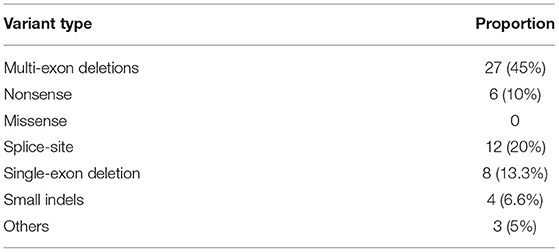Case Report: DOCK8 Deficiency Without Hyper-IgE in a Child With a Large Deletion
- 1Immunology Service, Hospital de Especialidades Unidad Medica de Alta Especialidad (UMAE) 25 del Instituto Mexicano del Seguro Social (IMSS), Monterrey, Mexico
- 2Pediatrics Service, Hospital de Especialidades Unidad Medica de Alta Especialidad (UMAE) 25 del Instituto Mexicano del Seguro Social (IMSS), Monterrey, Mexico
- 3Infectious Disease Department, Hospital de Especialidades Unidad Medica de Alta Especialidad (UMAE) 25 del Instituto Mexicano del Seguro Social (IMSS), Monterrey, Mexico
- 4Pediatrics Service, General Hospital 1, Saltillo, Mexico
- 5Immunodeficiencies Lab, National Institute of Pediatrics, Mexico City, Mexico
Autosomal recessive (AR) DOCK8 deficiency is a well-known actinopathy, a combined primary immune deficiency with impaired actin polymerization that results in altered cell mobility and immune synapse. DOCK8-deficient patients present early in life with eczema, viral cutaneous infections, chronic mucocutaneous candidiasis, bacterial pneumonia, and abscesses, together with eosinophilia, thrombocytosis, lymphopenia, and variable dysgammaglobulinemia that usually includes Hyper-IgE. In fact, before its genetic etiology was known, patients were described as having a form of Hyper-IgE syndrome, a name now deprecated in favor of genetic defects. We describe a school-age male patient with a clinical picture suggestive of DOCK8 deficiency, except for high serum IgE or a family history: early onset, failure to thrive, eczema, warts, condyloma, bronchiolitis, pneumonia, recurrent otitis media, bronchiectasis, candidiasis, leukocytosis, eosinophilia, high IgA, low IgG, and low CD4+ T cells. We were able to confirm the diagnosis through protein expression and whole-exome sequencing. We review the clinical, laboratory, and genetic features of 200 DOCK8-deficient patients; at least 4 other patients have had no elevated IgE, and about 40% do not have Hyper-IgE (above 1,000 IU/mL). Despite this, the constellation of signs, symptoms, and findings allow the suspicion of DOCK8 deficiency and other actinopathies.
Introduction
An estimated 7,000 individually rare diseases together afflict about 1 in every 17 humans (1). Individuals with rare diseases endure a diagnostic odyssey in which they consult an average of more than seven physicians for more than 6 years before someone suspects their correct diagnosis (2). Diagnostic errors are an important source of waste, complaints, complications, and deaths (3). Inborn errors of immunity (IEIs) are a group of congenital rare diseases with increased susceptibility to infection, autoimmunity, inflammation, allergy, and cancer (4). Combined immune deficiencies (CIDs), which stunt the numbers or responses of lymphocytes, are among the most severe IEIs (5); they manifest themselves since very early in life with adverse reactions to live vaccines, severe eczema, chronic diarrhea, atopic and/or bleeding diatheses, failure to thrive and opportunistic infections, as well as a life-long risk of autoimmune disease and malignancy.
Actinopathies are CIDs that prevent the polymerization of actin, thus impairing cell mobility and the immune synapse of hematopoietic cells (6). Autosomal recessive (AR) DOCK8 deficiency is one of the better-known actinopathies. The dedicator of cytokinesis 8 is a large protein that activates the small GTPase CDC42, which is essential for the reorganization of actin (7). DOCK8 also interacts with the WIP-WASp complex, regulates STAT3, and promotes a Th17 CD4+ differentiation (8, 9). The defective actin accumulates in natural killer (NK) cells and cripple their cytotoxicity function (10). Although DOCK8-deficient patients were first described as suffering from a type of Hyper-IgE syndrome (11), it soon became clear that this is a distinct entity of graver prognosis (12). Here, we describe the case of a DOCK8-deficient school-age boy with normal IgE serum levels, who nevertheless had other signs and findings that allowed suspecting the diagnosis.
Case Report
A 6-year-old male patient was referred to our care for a history of eczema, respiratory infections, warts, and mucocutaneous candidiasis. Born from a non-consanguineous family in Northern Mexico, he tolerated the Bacille Calmette-Guérin (BCG) vaccine shortly after birth, and his family history was significant only for two spontaneous abortions. He started at age 1 month old with extensive eczema attributed to cow's milk protein allergy. Later, the patient also developed one episode of bronchiolitis, three of pneumonia, and three of otitis media with effusion, as well as twice-a-month intermittent diarrhea, disseminated flat warts, chronic mucocutaneous candidiasis, and condyloma acuminatum around the scrotum and groin folds (see Figure 1).
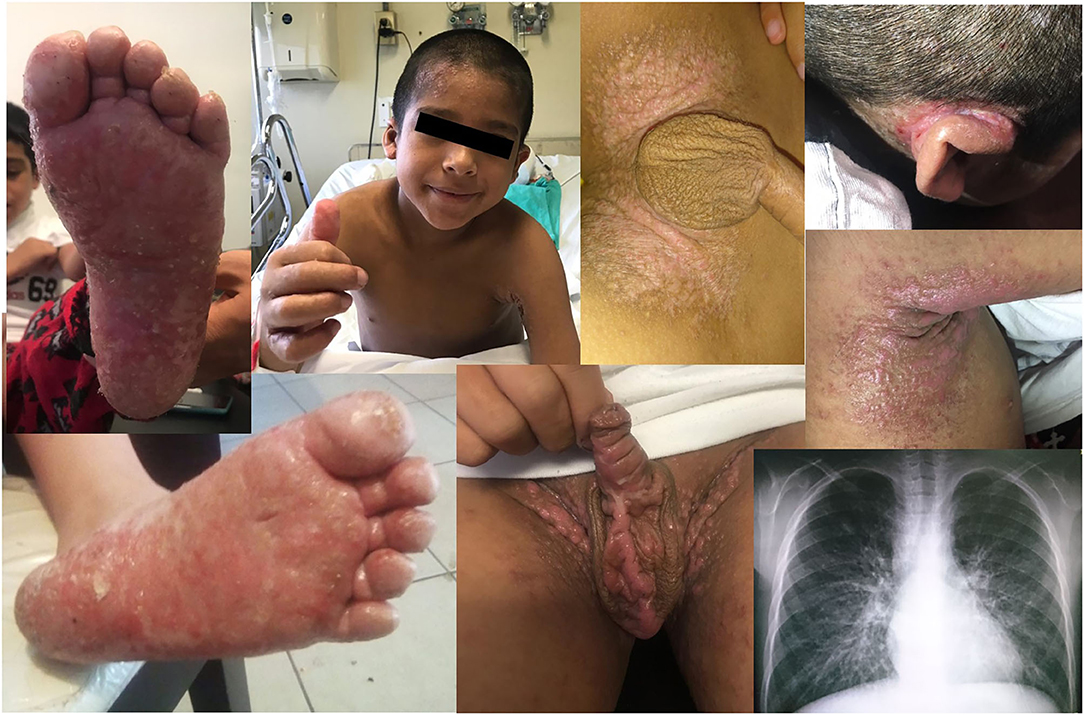
Figure 1. Some clinical features of DOCK8 deficiency. Plain warts and discolored skin patches in forehead, trunk, hands, and soles. Severe retroauricular and axillar eczema. Lower right corner: chest radiograph showing bilateral bronchiectases and perihilar interstitial infiltrates.
On physical examination, low weight, short stature, absent tonsils, a dry skin with extensive eczema, and mild hepatosplenomegaly were noted. Plain warts and discolored skin patches were corroborated in the forehead, trunk, hands, and soles, as well as mycotic skin lesions in feet and genitals.
High-resolution CT of the chest revealed bilateral bronchiectases. Blood counts reported leukocytosis (26,500–73,400 cells/mm3) and hyper-eosinophilia (14,900–30,000–75,000/mm3), with Hb 12.7 g/dL, neutrophils 9,570, lymphocytes 4,890, monocytes 1,520, and 252,000/mm3 platelets. Serum immunoglobulin G (IgG) was low at 408 mg/dL, with high IgA (550) and normal IgM (66 mg/dL); total serum IgE was marginally high at 95 IU/mL. CD4+ T cells were also low at 365 cells (33%), with the rest of lymphocyte subsets within the normal range (CD3+ 1,669, CD8+ 1,070, CD19+ 574, CD16/56+ 226 cells/mm3). Serologies for HIV, EBV, and CMV were all negative, as was a skin prick allergy test. The mitogen-induced carboxyfluorescein (CFSE) lymphoproliferation assay was equivocal: both the patient and a healthy (travel) control showed a limited response (see Figure 2).
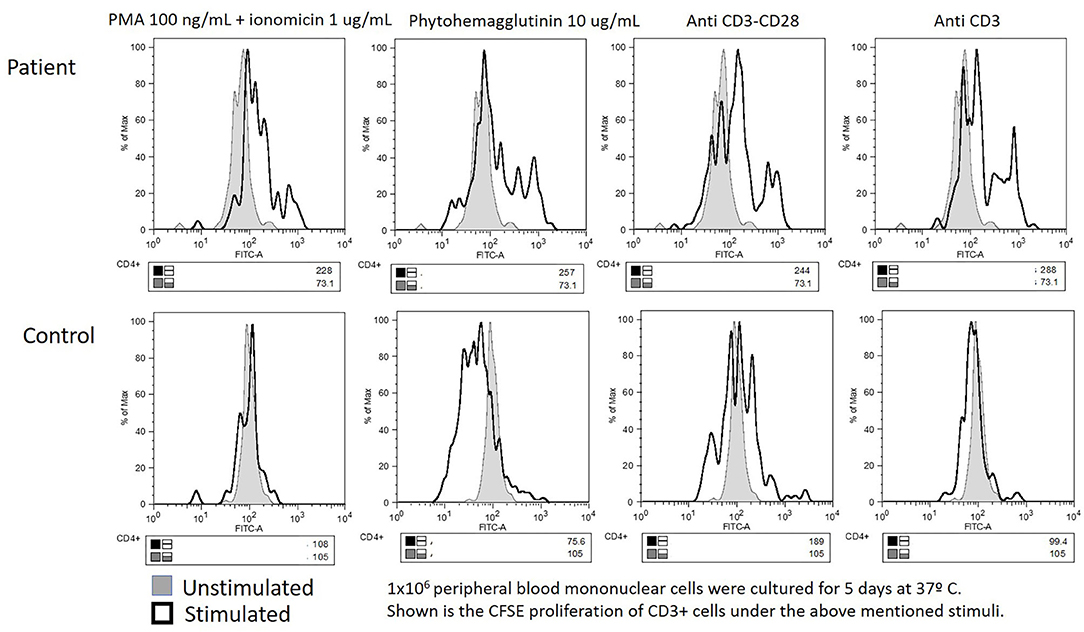
Figure 2. Equivocal carboxyfluorescein succinimidyl ester lymphoproliferation assay: impaired in both the patient's and the “travel control” blood samples.
A provisional diagnosis of CID was given. Alternative diagnoses we entertained for this patient were as follows: Wiskott–Aldrich syndrome (WAS), HIV/AIDS (CD4+ lymphopenia), and leukemia (hypereosinophilia). However, a bone marrow aspirate and a CGL myeloid mutation panel were reported as normal. Despite an almost normal serum IgE, DOCK8 deficiency was included in the differential diagnosis, considering the constellation of early onset, failure to thrive, eczema, warts, condyloma, bronchiolitis, pneumonia, recurrent otitis media, bronchiectasis, candidiasis, leukocytosis, eosinophilia, high IgA, low IgG, and low CD4+ lymphocytes.
Flow cytometry expression for WASp was slightly reduced in peripheral blood mononuclear cells, whereas DOCK8 expression was null (see Figure 3). Through whole exome sequencing (WES), we identified a large homozygous deletion that spans from introns 14 to 26, ~60,000 base pairs (Figure 4). The patient is currently stable under treatment with oral prophylactic antibiotics (TMP/SMZ and itraconazole), together with monthly intravenous immunoglobulin; he is awaiting hematopoietic stem-cell transplantation (HSCT).
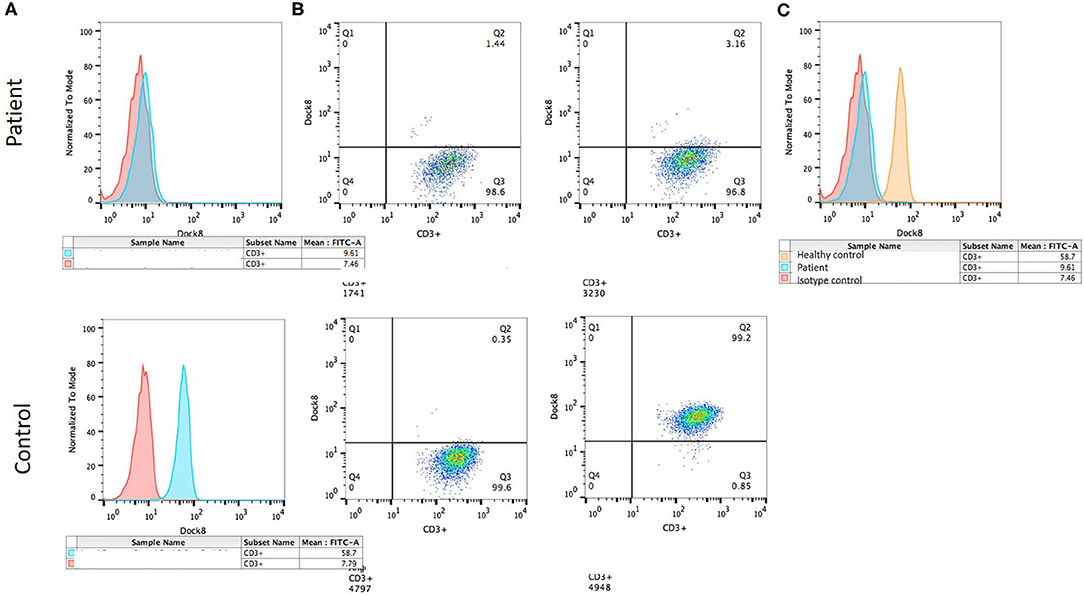
Figure 3. DOCK8 expression by flow cytometry. (A) Histograms showing mean fluorescence intensity: isotype control (red) and DOCK8 expression (blue) in the patient (above) and the healthy control (below). (B) Dot plot showing DOCK8 expression in CD3+ cells in the patient (above) and the control (below). (C) Histogram comparing DOCK8 expression in the healthy control (orange) and the patient (blue).
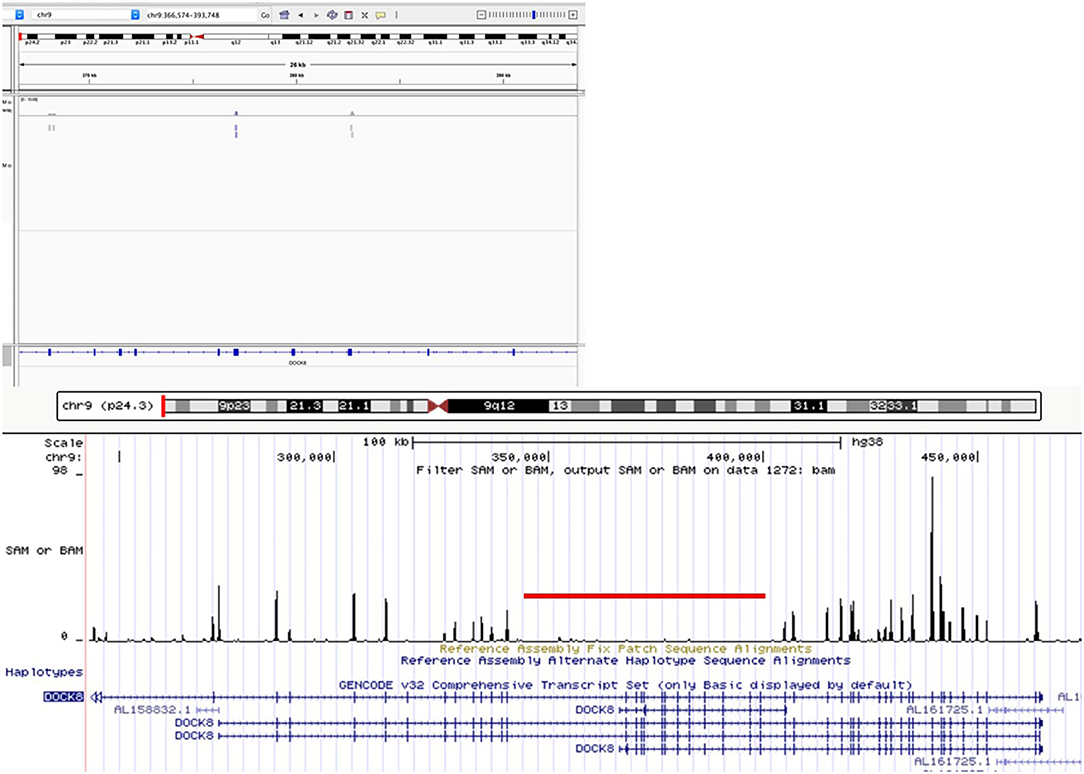
Figure 4. Whole-exome sequencing visualization on Integrative Genomics Viewer (IGV) and UCSC Genome browser, showing a large homozygous deletion of DOCK8 spanning introns 14 through 26, more than 50 kb.
Discussion
We describe a school-age male patient with an early onset of eczema, respiratory, and cutaneous infections caused by bacteria, viruses, and fungi. He developed hepatosplenomegaly, failure to thrive and bronchiectasis, hypereosinophilia, CD4+ lymphopenia, and dysgammaglobulinemia. Despite him not having Hyper-IgE, a high index of suspicion for DOCK8 deficiency led to a genetic diagnosis at age 7. DOCK8 expression was null, and a large genomic deletion, spanning introns 14 through 26, was identified through WES. Although this is a single atypical case, we were able to confirm the molecular (no protein expression) and genetic (large genomic deletion) diagnoses, while the patient awaits HSCT.
The differential diagnosis of suspected DOCK8 deficiency includes the Wiskott–Aldrich (eczema, respiratory infections, susceptibility to bacteria and viruses, high serum IgE), Loeys–Dietz (food allergies, arterial aneurysms, high IgE), complete DiGeorge (combined deficiency, mucocutaneous candidiasis, atopy), Comel–Netherton (brittle hair, eczema, eosinophilia, high IgE), IPEX (severe eczema, neonatal onset, eosinophilia, diarrhea, high IgE), and Omenn (alopecia, erythema, severe eczema, lymphopenia, eosinophilia, high IgE) syndromes; ARPC1B deficiency (thrombocytosis, eosinophilia, high IgG, IgA, and/or IgE), IRAK4/MyD88 deficiency (early onset of recurrent invasive bacterial infections, impaired inflammatory response + dysgammaglobulinemia/high IgE), CARD11 negative dominance (combined immune deficiency + atopy + high IgE), STAT3 negative dominance (eczema, cutaneous abscesses, chronic mucocutaneous candidiasis, high IgE), and its phenocopy ZNF341 deficiency; PGM3 (early onset eczema, rhinitis, asthma, recurrent bacterial, fungal and viral infections, bronchiectasis, skin vasculitis, lymphopenia, hypergammaglobulinemia, high IgE) and IL6ST (atopic dermatitis, food allergy, recurrent respiratory infections, eosinophilia, high IgE) deficiencies; MST1 (STK4) deficiency (warts, recurrent bacterial, viral and fungal infections, abscesses, autoimmunity, CD4+ lymphopenia); IL2RB deficiency (eczema, food allergies, combined deficiency with autoimmunity, lymphadenopathy, and hypergammaglobulinemia); and GATA2 haploinsufficiency (cutaneous viral infections, susceptibility to mycobacteria and fungi, bone marrow failure/myelodysplastic syndrome/leukemia, low B cells).
To date, more than 250 DOCK8-deficient patients have been described, 98% of which had high serum IgE (13, 14). At least four patients have been noted not to have elevated IgE, whereas almost 40% do not qualify as Hyper-IgE, defined as total serum IgE of more than 1,000 IU/mL. Most patients, however, have some degree of elevated serum IgE (i.e., >60 IU/mL), and about 95% have peripheral blood eosinophilia, together with some combination of eczema, food allergy, sinopulmonary bacterial, and cutaneous viral infections. It is thus the constellation of signs of symptoms, the clinical and laboratory gestalt, which supports the diagnostic suspicion of DOCK8 deficiency in the absence of Hyper-IgE, as in this case. Our patient had up to 56,680 eosinophils per mm3 at one point.
In 2016, Kienzler et al. described a DOCK8-deficient female patient without high serum IgE, who had compound heterozygous variants that resulted in a hypomorphic expression (15). Furthermore, they found a somatic reversion in T cells to which they attributed a much milder phenotype (no severe infection or atopy), despite having low CD4+ cells, low IgM and IgG, and impaired vaccine responses. Among the 136 patients included in Aydin et al.'s study (13), only 3 had serum IgE levels within the normal range (while in a dozen more, IgE was high without being “hyper”: below 1,000 IU/mL); all 3 had large genomic deletions and severe phenotypes. Patients with autosomal dominant (AD) STAT3 loss of function (LOF) without Hyper-IgE levels have also been reported (16).
The Hyper-IgE syndrome was first called “Job syndrome” and was then renamed when IgE was discovered and found to be markedly high in the serum of the originally described patients (17), whose phenotype was inherited in an AD fashion. Eventually, a group of autosomal recessive patients with a marginally similar phenotype (i.e., they shared a high serum IgE, eosinophilia, abscesses, and skin lesions) was characterized (11), and their genetic etiologies were identified between 2009 and 2018 (18–23). DOCK8 deficiency is classified, and better understood, as a combined immune defect; its prognosis and treatment are quite different from those of STAT3 loss of function. One common pitfall in our field is to think that all the so-called Hyper-IgE syndromes are the same, just with different etiologies; another important one is to rule out or accept the provisional diagnosis based on the misnomer “Hyper-IgE syndrome,” that is, to expect the total IgE serum levels to be “through the roof.”
More than once (16), the convenience of calling inborn errors of immunity diseases by their genetic defect and the need to abandon misleading or erroneous names such as Hyper-IgE and Hyper-IgM syndromes have been put forward (24). Our case report is yet another example. Apart from insisting in this change, we would also like to recall the most prevalent clinical, laboratory, and genetic features of DOCK8-deficient patients (see Tables 1–3): eczema, food allergy, molluscum/plain warts, abscesses, candidiasis, pneumonia, Hyper-IgE (98%), eosinophilia (96%), low IgM, and low T cells. Patients with DOCK8 deficiency have a life-long cumulative risk of developing aneurysm, cancer, and fatal infections, which is why the recommended treatment, the only one with curative potential, is HSCT.
To conclude, patients with DOCK8 deficiency may not have high total serum IgE levels, yet the astute clinician will maintain the diagnosis in his/her differential based on (any combination of) early onset eczema, food allergy, unusual infection, abscess, autoimmunity, eosinophilia, dysgammaglobulinemia, and CD3+ lymphopenia. “Hyper-IgE syndrome” is an incorrect name for several quite different diseases, from a time before their true nature was known, and we should abandon the misnomer in favor of more descriptive diagnoses and genetic etiologies.
Data Availability Statement
The original contributions presented in the study are included in the article/supplementary material, further inquiries can be directed to the corresponding author/s.
Ethics Statement
The studies involving human participants were reviewed and approved by Research and Ethics Committee, National Institute of Pediatrics. Written informed consent to participate in this study was provided by the participants' legal guardian/next of kin. Written informed consent was obtained from the minor(s)' legal guardian/next of kin for the publication of any potentially identifiable images or data included in this article.
Author Contributions
EV-M and AS-B cared for the patient, directed the diagnostic approach, wrote the manuscript, and reviewed the final version. LS-S, DM-Z, JG-C, RC-G, and YS-G cared for the patient and reviewed the final version of the manuscript. MG-S performed and analyzed the CFSE lymphoproliferation and protein expression by flow cytometry assays and reviewed the final version. SL processed and analyzed the whole-exome sequencing and conceived and wrote the manuscript. All authors contributed to the article and approved the submitted version.
Funding
Funding for sequencing was provided by the Innovation Stimuli Program, CONACYT 2016 and 2018 (Grant Nos. 232173 and 250030).
Conflict of Interest
The authors declare that the research was conducted in the absence of any commercial or financial relationships that could be construed as a potential conflict of interest.
Acknowledgments
We thank the Mexican Foundation for Children with Immunodeficiencies (FUMENI, AC) for assistance in shipping samples.
Abbreviations
AIDS, Acquired immune deficiency syndrome; AR, autosomal recessive; AD, autosomal dominant; BCG, Bacille Calmette-Guérin; DOCK8, Dedicator of cytokinesis 8; EBV, Epstein-Barr virus; HIV, human immunodeficiency virus; HSCT, hematopoietic stem-cell transplantation; IEI, inborn errors of immunity; IMSS, Mexican Institute of Social Security; INP, National Institute of Pediatrics; DNA, deoxyribonucleic acid; NK, natural killer.
References
2. Ronicke S, Hirsch MC, Türk E, Larionov K, Tientcheu D, Wagner AD. Can a decision support system accelerate rare disease diagnosis? Evaluating the potential impact of Ada DX in a retrospective study. Orphanet J Rare Dis. (2019) 14:69. doi: 10.1186/s13023-019-1040-6
3. Makary MA, Daniel M. Medical error-the third leading cause of death in the US. BMJ. (2016) 353:i2139. doi: 10.1136/bmj.i2139
4. Tangye SG, Al-Herz W, Bousfiha A, Chatila T, Cunningham-Rundles C, Etzioni A, et al. Human inborn errors of immunity: 2019 update on the classification from the international union of immunological societies expert committee. J Clin Immunol. (2020) 40:24–64. doi: 10.1007/s10875-019-00737-x
5. Notarangelo LD. Functional T cell immunodeficiencies (with T cells present). Annu Rev Immunol. (2013) 31:195–225. doi: 10.1146/annurev-immunol-032712-095927
6. Sprenkeler EGG, Webbers SDS, Kuijpers TW. When actin is not actin' like it should: a new category of distinct primary immunodeficiency disorders. J Innate Immun. (2020) 13:3–25. doi: 10.1159/000509717
7. McGhee SA, Chatila TA. DOCK8 immune deficiency as a model for primary cytoskeletal dysfunction. Dis Markers. (2010) 29:151–6. doi: 10.1155/2010/397291
8. Randall KL, Lambe T, Johnson AL, Johnson A, Treanor B, Kucharska E, et al. Dock8 mutations cripple B cell immunological synapses, germinal centers and long-lived antibody production. Nat Immunol. (2009) 10:1283–91. doi: 10.1038/ni.1820
9. Tangye SG, Pillay B, Randall KL, Avery DT, Phan TG, Gray P, et al. Dedicator of cytokinesis 8–deficient CD4+ T cells are biased to a TH2 effector fate at the expense of TH1 and TH17 cells. J Allergy Clin Immunol. (2017) 139:933–49. doi: 10.1016/j.jaci.2016.07.016
10. Crawford G, Enders A, Gileadi U, Stankovic S, Zhang Q, Lambe T, et al. DOCK8 is critical for the survival and function of NKT cells. Blood. (2013) 122:2052–61. doi: 10.1182/blood-2013-02-482331
11. Renner ED, Puck JM, Holland SM, Schmitt M, Weiss M, Frosch M, et al. Autosomal recessive hyperimmunoglobulin E syndrome: a distinct disease entity. J Pediatr. (2004) 144:93–9. doi: 10.1016/S0022-3476(03)00449-9
12. Al Mutairi M, Al-Mousa H, Alsaud B, Hawwari A, Aljoufan M, Alwesaibi A, et al. Grave aortic aneurysmal dilatation in DOCK8 deficiency. Mod Rheumatol. (2014) 24: 690–93. doi: 10.1007/s10165-012-0820-9
13. Aydin SE, Kilic SS, Aytekin C, Kumar A, Porras O, Kainulainen L, et al. DOCK8 deficiency: clinical and immunological phenotype and treatment options - a review of 136 patients. J Clin Immunol. (2015) 35:189–98. doi: 10.1007/s10875-014-0126-0
14. Engelhardt KR, Gertz ME, Keles S, Schäffer AA, Sigmund EC, Glocker C, et al. The extended clinical phenotype of 64 patients with dedicator of cytokinesis 8 deficiency. J Allergy Clin Immunol. (2015) 136:402–12. doi: 10.1016/j.jaci.2014.12.1945
15. Kienzler AK, van Schouwenburg PA, Taylor J, Marwah I, Sharma RU, Noakes C, et al. Hypomorphic function and somatic reversion of DOCK8 cause combined immunodeficiency without Hyper-IgE. Clin Immunol. (2016) 163:17–21. doi: 10.1016/j.clim.2015.12.003
16. Zhang Q, Boisson B, Béziat V, Puel A, Casanova JL. Human Hyper-IgE syndrome: singular or plural? Mamm Genome. (2018) 29:603–17. doi: 10.1007/s00335-018-9767-2
17. Buckley RH, Wray BB, Belmaker EZ. Extreme hyperimmunoglobulinemia E and undue susceptibility to infection. Pediatrics. (1972) 49:59–70.
18. Zhang Q, Davis JC, Lamborn IT, Freeman AF, Jing H, Favreau AJ. Combined immunodeficiency associated with DOCK8 mutations. N Engl J Med. (2009) 361:2046–55. doi: 10.1056/NEJMoa0905506
19. Engelhardt KR, McGhee S, Winkler S, Sassi A, Woellner C, Lopez-Herrera G, et al. Large deletions and point mutations involving the dedicator of cytokinesis 8 (DOCK8) in the autosomal-recessive form of Hyper-IgE syndrome. J Allergy Clin Immunol. (2009) 124:1289–302.e4. doi: 10.1016/j.jaci.2009.10.038
20. Zhang Y, Yu X, Ichikawa M, Lyons JJ, Datta S, Lamborn IT, et al. Autosomal recessive phosphoglucomutase 3 (PGM3) mutations link glycosylation defects to atopy, immune deficiency, autoimmunity, and neurocognitive impairment. J Allergy Clin Immunol. (2014) 133:1400–9:1409.e1–5. doi: 10.1016/j.jaci.2014.02.013
21. Chavanas S, Bodemer C, Rochat A, Hamel-Teillac D, Ali M, Irvine AD, et al. Mutations in SPINK5, encoding a serine protease inhibitor, cause Netherton syndrome. Nat Genet. (2000) 25:141–2. doi: 10.1038/75977
22. Schwerd T, Twigg SRF, Aschenbrenner D, Manrique S, Miller KA, Taylor IB, et al. A biallelic mutation in IL6ST encoding the GP130 coreceptor causes immunodeficiency and craniosynostosis. J Exp Med. (2017) 214:2547–62. doi: 10.1084/jem.20161810
23. Béziat V, Li J, Lin JX, Ma CS, Li P, Bousfiha A, et al. A recessive form of Hyper-IgE syndrome by disruption of ZNF341-dependent STAT3 transcription and activity. Sci Immunol. (2018) 3:eaat4956. doi: 10.1126/sciimmunol.aat4956
Keywords: DOCK8 deficiency, large deletion, Hyper-IgE, case report, combined immune deficiency, literature review
Citation: Venegas-Montoya E, Staines-Boone AT, Sánchez-Sánchez LM, García-Campos JA, Córdova-Gurrola RA, Salazar-Galvez Y, Múzquiz-Zermeño D, González-Serrano ME and Lugo Reyes SO (2021) Case Report: DOCK8 Deficiency Without Hyper-IgE in a Child With a Large Deletion. Front. Pediatr. 9:635322. doi: 10.3389/fped.2021.635322
Received: 30 November 2020; Accepted: 19 April 2021;
Published: 14 June 2021.
Edited by:
Stephen Jolles, University Hospital of Wales, United KingdomReviewed by:
Beatriz Elena Marciano, National Institutes of Health (NIH), United StatesAndrea Taddio, Institute for Maternal and Child Health Burlo Garofolo (IRCCS), Italy
Copyright © 2021 Venegas-Montoya, Staines-Boone, Sánchez-Sánchez, García-Campos, Córdova-Gurrola, Salazar-Galvez, Múzquiz-Zermeño, González-Serrano and Lugo Reyes. This is an open-access article distributed under the terms of the Creative Commons Attribution License (CC BY). The use, distribution or reproduction in other forums is permitted, provided the original author(s) and the copyright owner(s) are credited and that the original publication in this journal is cited, in accordance with accepted academic practice. No use, distribution or reproduction is permitted which does not comply with these terms.
*Correspondence: Edna Venegas-Montoya, e.venegasm@hotmail.com
 Edna Venegas-Montoya1*
Edna Venegas-Montoya1*  David Múzquiz-Zermeño
David Múzquiz-Zermeño María Edith González-Serrano
María Edith González-Serrano Saul O. Lugo Reyes
Saul O. Lugo Reyes